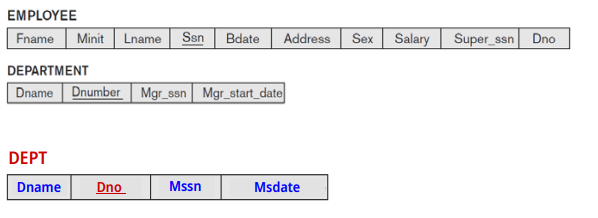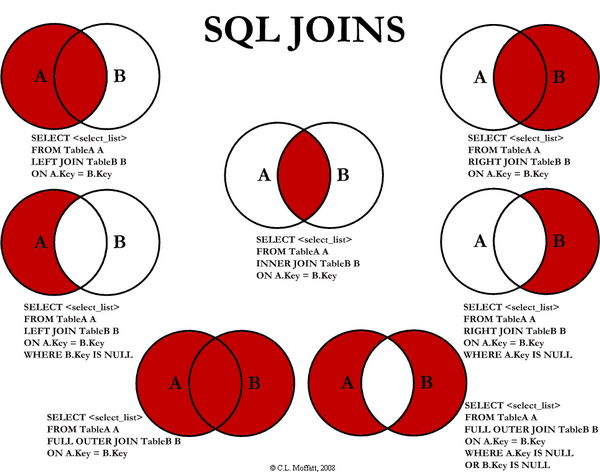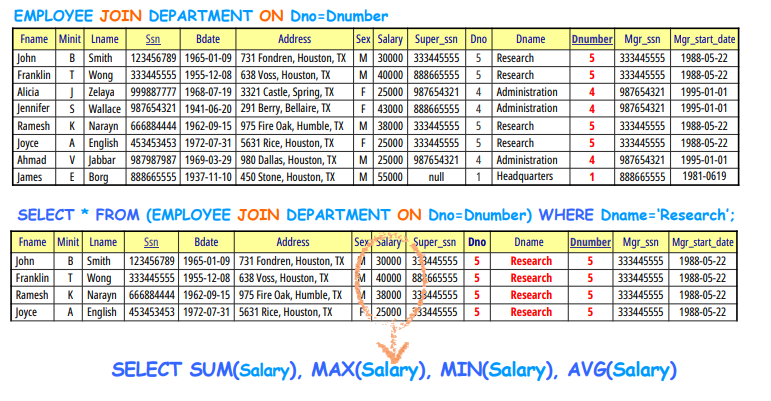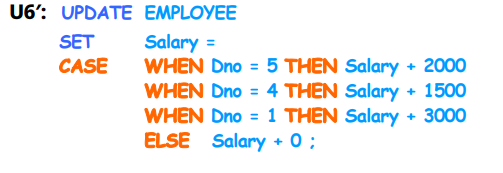| 일 | 월 | 화 | 수 | 목 | 금 | 토 |
|---|---|---|---|---|---|---|
| 1 | ||||||
| 2 | 3 | 4 | 5 | 6 | 7 | 8 |
| 9 | 10 | 11 | 12 | 13 | 14 | 15 |
| 16 | 17 | 18 | 19 | 20 | 21 | 22 |
| 23 | 24 | 25 | 26 | 27 | 28 | 29 |
| 30 |
- spring security
- lombok
- Google OAuth
- Volatile
- OAuth 2.0
- Dependency Injection
- Spring
- java
- synchronized
- nestjs
- factory
- builder
- 일급 객체
- middleware
- 일급 컬렉션
- Today
- Total
HJW's IT Blog
DB: Chapter 7(Complex Queries) 본문
#Comparisons Involving NULL & Three-Valued Logic
> NULL : unknown value, not applicable attribute
> Three-valued Logic

> IS [NOT] NULL
ex) Retrieve the names of all employees who do not have supervisors
SELECT Fname, Lname
FROM EMPLOYEE
WHERE Super_ssn IS NULL
> IN 연산

> 중첩 질의 (Nested Query)

> PROJECT 테이블에서 Dnum 이 5 인요소들의 Pnumber 를 골라 해당하는 Pname 을 출력

SELECT Pname
FROM PROJECT
WHERE Plocation='Huston' OR Dnum = 4;
SELECT Pname
FROM PROJECT
WHERE Pnumber IN(3,20) OR Pnumber IN (10,30);
SELECT Pname
FROM PROJECT
WHERE Pnumber IN
(SELECT Pnumber FROM PROJECT
WHERE Plocation='Huston')
OR
Pnumber IN
(SELECT Pnumber FROM PROJECT
WHERE Dnum=4);위 SQL 질의의 결과 는 모두 같다
> QUERY) Make a list of all project numbers for projects that involve an employee whose last name is 'Smith', either as a worker or as a manager of the department
SELECT DISTINCT Pnumber
FROM PROJECT, DEPARTMENT, EMPLOYEE
WHERE Dnum = Dnumber AND Mgr_ssn = SSN AND Lname='Smith'
UNION
SELECT DISTINCT Pno
FROM WORKS_ON, EMPLOYEE
WHERE Essn=Ssn AND Lname='Smith';
SELECT DISTINCT Pnumber
FROM PROJECT
WHERE Pnumber IN
(SELECT DISTINCT Pnumber
FROM PROJECT, DEPARTMENT, EMPLOYEE
WHERE Dnum=Dnumber AND Mgr_ssn=Ssn AND Lname='Smith')
OR Pnumber IN
(SELECT DISTINCT Pno
FROM WORKS_ON,EMPLOYEE
WHERE Essn=Ssn AND Lname='Smith');
>QUERY) Retrieve the name of each employee who has a dependent with the same first name and same sex as the employee.
SELECT E.Fname, E.Lname
FROM EMPLOYEE AS E
WHERE E.Ssn IN (
SELECT Essn
FROM DEPENDENT
WHERE E.Fname = Dependent_name AND E.Sex=Sex);
#EXISTS and UNIQUE Functions
> Exists는 Correlated nested query 가 비어있는지 아닌지 확인
> 즉, true or false 반환
> UNIQUE는 만약 튜플이 유일하면 true 아니면 false
>QUERY) Retrieve the names of employees who have no dependents
SELECT Fname, Lname
FROM EMPLOYEES
WHERE NOT EXISTS
(SELECT *
FROM DEPENDENT
WHERE Ssn=Essn);SELECT Fname,Lname
FROM EMPLOYEE
WHERE UNIQUE
( SELECT Sex
FROM DEPENDENT
WHERE Essn=EMPLOYEE.Ssn);> QUERY) List the names of managers who have at least one dependent
SELECT Fname, Lname
FROM EMPLOYEE
WHERE EXISTS (SELECT *
FROM DEPENDENT
WHERE Ssn=Essn)
AND
EXISTS(SELECT *
FROM DEPARTMENT
WHERE Ssn=Mgr_ssn);
#Explicit Sets and Renaming Attributes
SELECT E.Lname AS Emp_Name, S.Lname AS Spvsr_Name
FROM EMPLOYEE AS E, EMPLOYEE AS S
WHERE E.Super_ssn=S.Ssn;
#Joined Table
SELECT Fname, Lname, Address
FROM (EMPLOYEE JOIN DEPARMENT ON Dno=Dnumber)
WHERE Dname='Research';

> JOIN 의 결과물
>> Dno 와 Dnumber 이 같은 튜플끼리 묶는것
>JOIN 의 종류: NATURAL JOIN, OUTER JOIN
NATURAL JOIN 에서
> join condition 이 없다
SELECT Fname,Lname, Address
FROM (EMPLOYEE NATURAL JOIN
(DEPARTMENT AS DEPT(Dname, Dno, Mssn, Msdate)))
WHERE Dname='Research';
> INNER JOIN : 두 집합에 모두 있는 열만 남음
> LEFT OUTER JOIN: A 와 B 테이블이 있다면 A의 모든열 + B에 있는 공통 부분
> RIGHT OUTER JOIN: B의 모든열+ A에 있는 공통 부분
> FULL OUTER JOIN: A와 B의 합집합

#MULTIWAY JOIN
SELECT Pnumber, Dnum, Lname, Address, Bdate
FROM ((PROJECT JOIN DEPARTMENT ON Dnum=Dnumber JOIN EMPLOYEE ON Mgr_ssn=Ssn)
WHERE Plocation='Stafford';
#Aggregate Function
총 5가지 aggregate functions.
-> COUNT, SUM, MAX, MIN, AVG
>Query) Find the sume of the salaries of all employees, the maximum salary, the minimum salary and the avg salary
SELECT SUM(Salary), MAX(Salary), MIN(Salary), AVG(Salary)
FROM EMPLOYEE> Query) Find the sum of the salaries of all employees of the 'Research' department, as well as the max salary , the min salary, and the avg salary in this department.
SELECT SUM(Salary), MAX(Salary), MIN(Salary), AVG(Salary)
FROM(EMPLOYEE JOIN DEPARMENT ON Dno=Dnumber)
WHERE Dname='Research';
> Query) Retrieve the total number of employees in the compary and the number of employees in the 'Research' department
SELECT COUNT(*) FROM EMPLOYEE;
SELECT COUNT(*)
FROM EMPLOYEE, DEPARMENT
WHERE Dno=Dnumber AND Dname='Research';
> Query) Count the number of distinct salary values in the db
SELECT COUNT(DISTINCT Salary)
FROM EMPLOYEE;> Query) Retrieve the names of all employees who have two or more dependents
SELECT Fname, Lname
FROM EMPLOYEE
WHERE ( SELECT COUNT(*) FROM DEPENDENT WHERE Ssn=Essn) >=2;
#Grouping: GROUP BY and HAVING
> Query) For each department, retrieve the deparment number, the number of employees in the department, and their avg salary
SELECT Dno, COUNT(*), AVG(Salary)
FROM EMPLOYEE
GROUP BY Dno;
> Query) For each project, retrieve the project number, the project name and the number of employees who work on that project
SELECT Pnumber, Pname, COUNT(*)
FROM PROJECT, WORKS_ON
WHERE Pnumber = Pno
GROUP BY Pnumber, Pname;

>Query) For each projcet, retrieve the project number, the project name, and the number of employees from department 5 who work on the project
SELECT Pnumber, Pname, COUNT(*)
FROM PROJECT, WORKS_ON, EMPLOYEE
WHERE Pnumber=Pno AND Ssn=Essn AND Dno = 5
GROUP BY Pnumber, Pname;>Query) Count the total number of employees whose salaries exceed $40,000 in each department but only for department wher more than 3 employees work
SELECT Dno, COUNT(*)
FROM EMPLOYEE
WHERE Salary>40000
GROUP BY Dno
HAVING COUNT(*)>3;>Query) For each department that has more than 3 employees, retrieve the department number and the number of its employees who are making more than $40,000
SELECT Dno, COUNT(*)
FROM EMPLOYEE
WHERE Salary>40000 AND Dno IN (
SELECT Dno
FROM EMPLOYEE
GROUP BY Dno
HAVING COUNT(*) > 3)
GROUP BY Dno;
#WITH and CASE
>Query) For each department that has more than 3 employees, retrieve the department number and the number of its employees who are making more than $40,000
WITH BIGDEPTS(Dno) AS(
SELECT Dno
FROM EMPLOYEE
GROUP BY Dno
HAVING COUNT(*) > 3)
SELECT Dno, COUNT(*)
FROM EMPLOYEE
WHERE Salary>40000 AND Dno IN BIGDEPTS
GROUP BY Dno;CASE)

'Database' 카테고리의 다른 글
| PostgreSQL 격리 수준 제대로 이해하기: MVCC·VACUUM·SSI (3) | 2025.08.24 |
|---|---|
| [Database Studio] 2주 수업 정리 (0) | 2024.05.26 |
| Complex Query 2 (0) | 2023.09.22 |
| DataBase: 3주 (0) | 2023.09.09 |
| Database: 1주차 (0) | 2023.08.29 |


